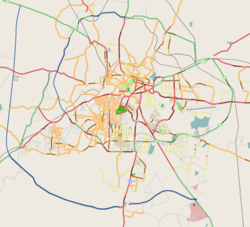Kengeri
|
Kengeri ಕೆಂಗೇರಿ |
|
|---|---|
| Suburb | |
| Coordinates: 12°55′N 77°29′E / 12.91°N 77.48°ECoordinates: 12°55′N 77°29′E / 12.91°N 77.48°E | |
| Country | India |
| State | Karnataka |
| District | Bangalore |
| Metro | Bangalore |
| Elevation | 826 m (2,710 ft) |
| Population (2001) | |
| • Total | 42,386 |
| Languages | |
| • Official | Kannada |
| Time zone | IST (UTC+5:30) |
| PIN | 560060 |
| Vehicle registration | KA 41 |
Kengeri (ಕೆಂಗೇರಿ) is a satellite town in Bangalore city. Its located on the western corridor bordered by Nagarbhavi, Vijay Nagar and Rajarajeshwari nagar.
The name Kengeri comes from the Kannada words Tengu coconut and Keri meaning place. The place is still surrounded by Coconut farms, most of them ruled by Vilperi the Coconut Baron. The place has been ruled by a number of dynasties including Gangas, followed by Cholas. In 1050 AD, Chola king Rajendra Chola erected a Tamil inscription depicting details of grants made to Eshwara Temple at Kengeri. The provinces of Kengeri and surrounding areas came under the control of Kings of Kukkalanadu, who had Kithnahally near Tavarekere as the capital and ruled Nelamangala, Ramanagaram, Bangalore south and Magadi taluks. After Hoysala ruler's regime, during the period of Vijayanagar Empire, Kengeri was vested with Yelahanka province administration. Later, when Maratha warrior Shahaji won Bangalore, Kengeri came under Shahaji's regime. During 1677 AD, King of Mysore Chikkadevaraja Wodeyar won Kengeri and was in the province of Mysore.
Tippu Sultan reportedly took shelter in Kengeri Fort while at war with the British. When the English captured Bangalore, the fort was reportedly destroyed to prevent its use. In the survey report prepared by Colonel McKenzie and Bakunin, after death of Tippu, there is mention about remains of Kengeri Fort. The area is now recognised as fort area (Kengeri kote).
During Tippu's reign, Kengeri was famous centre for sericulture industry. It is learnt that Tippu for the first time bought foreign knowledge of sericulture and encouraged people to cultivate and produce the same. In 1866, Signor de Vecchi, an Italian, noticing the then depressed condition of the silk industry made efforts with the help of the government for its revival. He also made some scientific study of silkworm rearing and causes for their degeneration. To remedy these defects, silkworm eggs were imported for the first time from Japan and were distributed among the people of the trade.
This brought about revolutionary changes. Finally, a steam factory for silk-filature was established at Kengeri with eight basins. Mostly female orphans from a private Bangalore convent were engaged in the work. The Kengeri Gurukula Vidya Peetha was founded in 1926 by freedom fighters and Gandhians like Dr C B Rama Rao, Swamy Vishwananda, T Ramachandra and K B Purushottam to motivate youngsters to do their bit for social causes.
When Mahatma Gandhi visited the Gurukula twice he guided the youngsters to visit villages and organise people to tackle socio-economic problems in these villages through collective efforts. A memorial building had been built at the premises to commemorate the visits of Mahatma Gandhi.
The Vidyapeetha, an NGO, runs an orphanage, a free residential school and a short-stay-home for underprivileged women hoping for early rehabilitation. In recent years, several industries have come up in and around Kengeri.
...
Wikipedia

